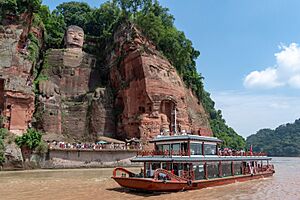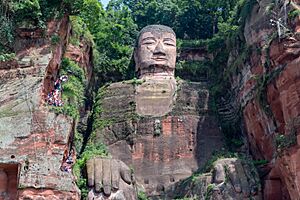Leshan Giant Buddha facts for kids
| UNESCO World Heritage Site | |
|---|---|

Tourists viewing Leshan Giant Buddha from ship
|
|
| Location | Sichuan, China |
| Part of | Mount Emei Scenic Area, including Leshan Giant Buddha Scenic Area |
| Criteria | Cultural and Natural: (iv)(vi)(x) |
| Inscription | 1996 (20th Session) |
| Leshan Giant Buddha | |||||||||||
|---|---|---|---|---|---|---|---|---|---|---|---|
| Simplified Chinese | 乐山大佛 | ||||||||||
| Traditional Chinese | 樂山大佛 | ||||||||||
|
|||||||||||
The Leshan Giant Buddha (Chinese: 樂山大佛) is an amazing stone statue, about 71 meters (233 feet) tall. It was carved right into a cliffside between the years 713 and 803 AD, during the Tang dynasty in China. You can find it in the southern part of Sichuan Province, near the city of Leshan.
This huge Buddha statue sits where three rivers meet: the Min River, the Qingyi River, and the Dadu River. It faces Mount Emei, with the rivers flowing peacefully at its feet. It's the biggest and tallest stone Buddha statue anywhere in the world! It's also the tallest statue made before modern times.
The area around the Buddha, known as the Mount Emei Scenic Area, including the Leshan Giant Buddha Scenic Area, was named a UNESCO World Heritage Site in 1996. This means it's a very special place that the world wants to protect.
Contents
Where is the Leshan Giant Buddha Located?
The Leshan Giant Buddha is carved into the side of Lingyun Mountain, specifically at a spot called Qifeng Peak. This peak is exactly where the Minjiang River, Qingyi River, and Dadu River all come together.
The area around the Buddha is also rich in history. You can find ancient cliff tombs and homes carved into the rocks. For example, the Mahao Cliff Tombs near the Buddha were built during the Han dynasty. They show us how people lived a very long time ago.
The History of the Giant Buddha
How the Statue Was Started
Work on the Leshan Giant Buddha began in 723 AD. A Buddhist monk named Hai Tong led the project. He wanted to build the Buddha to calm the wild and dangerous river currents. These currents often caused problems for ships traveling on the river.
It is said that when money for the project was running out, Hai Tong even removed his own eyes. He did this to show how truly devoted and serious he was about building the Buddha.
Completing the Buddha
After Hai Tong passed away, the construction stopped for a while because there wasn't enough money. At that time, only the upper part of the statue, from the shoulders up, was finished.
Years later, Hai Tong's students continued the work. They received financial help from a local official named Zhangchou Jianxiong. The students worked until the statue reached the knees. Then, construction stopped again because Zhangchou Jianxiong was called back to the royal court.
About 70 years later, another official named Wei Gao provided more support and money. Finally, Hai Tong's students completed the entire statue in 803 AD.
The Buddha's Shelter and Repairs
When the Giant Buddha was first carved, a huge wooden structure was built around it. This structure had thirteen stories and protected the statue from rain and sun. However, this wooden shelter was destroyed by soldiers during wars at the end of the Yuan dynasty. After that, the stone Buddha was left open to the weather.
Over time, the Buddha needed repairs. During the Northern Song dynasty, the statue was covered in moss, and its wooden pavilion had fallen apart. The Giant Buddha was repaired on a large scale during the reign of Song Renzong, and the wooden pavilion was rebuilt.
Interestingly, the huge amount of stone removed from the cliff to create the Buddha actually changed the river currents. This made the water safer for passing ships, just as Hai Tong had hoped!
How the Buddha Stays Strong
A Clever Drainage System
The Leshan Giant Buddha has a very smart drainage system built into it. This system was designed when the statue was first made, and it still works today! It helps protect the Buddha from damage caused by rain.
Hidden drainage pipes are carved into different parts of the statue's body. These pipes carry water away after it rains, which helps to reduce wear and tear on the stone. This complex system has kept the statue safe for over 1,200 years.
Protecting the Ancient Statue
The Leshan Giant Buddha has faced challenges from pollution and lots of visitors. Pollution from nearby development and air pollution have caused some damage. Weather and tourism have also affected the statue.
To help with this, the government has promised to do restoration work. Scientists are also studying how tiny living things like lichen and plants on the Buddha's body affect the stone. They hope to learn more to better protect this amazing statue.
What the Buddha Looks Like
The statue shows a seated Buddha with his hands resting on his knees. It is 71 meters (233 feet) tall. His shoulders are 28 meters (92 feet) wide. Even his smallest toenail is big enough for a person to sit on!
There's a local saying: "The mountain is a Buddha and the Buddha is a mountain." This is because the mountain range where the Buddha is located looks like a sleeping Buddha when seen from the river. The Leshan Giant Buddha itself forms the heart of this "sleeping Buddha."
The Buddha's hair is made up of 1,021 spiraled curls carved into his head. His ears are 7 meters (23 feet) long and are big enough to hold two people inside. His eyebrows are 5.6 meters (18 feet) long, and his fingers are 8.3 meters (27 feet) long. His nose is also 5.6 meters (18 feet) long.
His mouth and eyes are each 3.3 meters (11 feet) wide. The top of his foot is about 8.5 meters (28 feet) wide and can hold around one hundred people! This statue is as tall as a ten-story building. If the Statue of Liberty stood upright, it would be about the same size.
The Buddha's body is perfectly balanced and shaped according to ancient Buddhist art rules. It has a calm and peaceful look, which was typical for statues made during the Tang dynasty.
Visiting the Leshan Giant Buddha
The Leshan Giant Buddha is one of the most popular places to visit in Sichuan province. Millions of tourists come each year to see this incredible statue. This has helped the local economy by creating jobs and income.
However, too many visitors can sometimes affect the statue's quality. So, the local government has set rules to help protect the Buddha. The Leshan Giant Buddha is especially popular during Chinese New Year, when many people come to pray for good luck.
How to Get There and What to Expect
The easiest way to reach the Giant Buddha from Leshan Town is by taking local bus 13. Once you arrive, you'll need to buy a ticket. The ticket price is CNY 90 per person, and it includes entry to Wuyou Temple and the Mahao Cliff Tombs.
The site is open from 7:30 AM to 6:30 PM from April to October. From October to March, it's open from 8:00 AM to 5:30 PM. Weekends and holidays are usually much busier than weekdays.
Besides the main Buddha statue, there are many pathways to explore around the mountain. You can walk along a pedestrian path that takes you very close to the Buddha. This path lets you see the statue from different angles. Be aware that these paths can be steep and narrow.
If you want a wider view of the Buddha, you can take a sightseeing boat. These boats cost CNY 70 per person and can hold about 35 passengers. You might have to wait in line for a boat, especially on busy days.
Images for kids
See also
- Laykyun Sekkya
- Great Buddha of Thailand
- The Big Buddha (Hong Kong)
- Buddha Dordenma statue
- Great Buddha
- Buddhist art
- Chinese Buddhism
- Tang dynasty
- List of tallest statues









